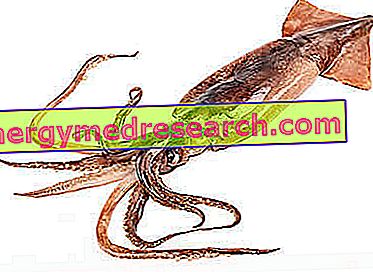What is the totano?
Totano is the name of underwater marine creatures belonging to the Phylum of the Molluscs, the Class of Cephalopods and the Family of Ommastrephidae .

In Italy, the most commercially important species is the common squid or Todarodes sagittatus ; on a global level, however, the most fished is the Pacific squid or Todarodes pacificus .
Curiosity: flying squid
Some species of squid have the ability to emerge and glide over the surface of the water; for this reason they are also known as "flying squids".
The squid is a product of fishing that is part of the gastronomic culture of almost all over the world.
In Italy it is mainly consumed roast, boiled, stewed, sautéed and fried; it is considered a valid, often less expensive, substitute for the more prized squid (even if they are biologically very different creatures).
From the nutritional point of view, the squid is part of the fundamental group of foods, as it is rich in proteins with high biological value, specific vitamins and mineral salts.
The squid cannot be bred and is fished quite intensively; fortunately, it seems that the population of the various species of squid is still quite numerous.
Nutritional properties
Nutritional characteristics of squid
Due to its remarkable similarity, the nutritional characteristics of the squid are generally compared to those of the squid. As the composition of the two animals is almost completely identical, below we will report the nutritional data provided by INRAN (National Research Institute for Food and Nutrition) on fresh and frozen squid.
| Squid, fresh | Squid, frozen | ||
| Edible part | 65.0% | 59.0% | |
| water | 80, 0g | 84, 2g | |
| Protein | 12, 6g | 13, 1g | |
| Prevailing amino acids | - | - | |
| Limiting amino acid | - | - | |
| Lipids TOT | 1, 7g | 1.5g | |
| Saturated fatty acids | 0, 85mg | - mg | |
| Monounsaturated fatty acids | 0, 46mg | - mg | |
| Polyunsaturated fatty acids | 0, 40mg | - mg | |
| Cholesterol | 64, 0mg | 63, 0mg | |
| TOT Carbohydrates | 0.6g | 0.6g | |
| Glycogen | 0.0g | 0.0g | |
| Soluble sugars | 0.6g | 0.6g | |
| Dietary fiber | 0.0g | 0.0g | |
| Soluble fiber | 0.0g | 0.0g | |
| Insoluble fiber | 0.0g | 0.0g | |
| Power | 68, 0kcal | 68, 0kcal | |
| Sodium | 185, 0mg | 185, 0mg | |
| Potassium | 145, 0mg | 145, 0mg | |
| Iron | 0.2mg | 0.2mg | |
| Football | 144, 0mg | 130, 0mg | |
| Phosphorus | 189, 0mg | 170, 0mg | |
| Magnesium | 22 mg | - mg | |
| Zinc | 3.1 mg | - mg | |
| Copper | 1.2 mg | - mg | |
| Selenium | - mg | - mg | |
| Thiamine | 0, 07mg | 0.05 mg | |
| Riboflavin | 0, 16mg | 0, 02mg | |
| Niacin | 1, 20mg | 2, 10mg | |
| Vitamin A | 75, 0μg | 75, 0μg | |
| C vitamin | tr | tr | |
| Vitamin E | - mg | - mg | |
The squid is a food that belongs to the fundamental group of foods.
It has a moderate energy supply. The calories come mainly from proteins, followed by low amounts of lipids; the carbohydrates are almost completely absent.
Peptides are of high biological value and contain significant amounts of sulfur amino acids; fatty acids are mainly unsaturated. Cholesterol is significant, while fibers are absent.
Regarding vitamins, the totano contains excellent levels of riboflavin (B2) and niacin (PP); as far as mineral salts are concerned, sodium, calcium, phosphorus and potassium concentrations are good.
The squid lends itself to most feeding regimes, including those for metabolic pathologies and against overweight; being low in calories, it is very useful in the nutritional system for obesity.
For those suffering from diseases or impaired digestion (dyspepsia, gastritis, ulcer, gastro-esophageal reflux disease, etc.) it is advisable to avoid considerable portions of this food in the evening hours.
The squid is a food that can trigger allergic reactions and its inclusion in the child's diet should occur at a non-critical age. It does not contain gluten and lactose.
It does not lend itself to vegetarian and vegan philosophy, nor to Jewish, Muslim and Hindu religious food. The average portion of squid is 150 g (about 100 kcal).
Kitchen
Gastronomic uses of the squid
The squid has the same gastronomic uses as the squid, so much so that often the two products are (even fraudulently) marketed for each other.
Small and whole ones are ideal for frying; the same recipe can also be made with the body of larger specimens (maximum 50 cm) cut into rings. Note : many prefer not to fry the squid heads and keep them for other recipes such as fish risotto, pasta sauce or seafood soups.
Roasted and baked stuffed squids are famous. They also represent a "substitute" ingredient of cuttlefish and octopus in mixed boiled fish (cold starter). Note : very large squid have a lower gastronomic value, since they have tough, chewy and hard meats (very rarely they cook squid from 6-7 kg i su); the only cooking systems that can make them palatable are the cooked, in a pan or in the oven, with tomato sauce and / or onion.
Conservation of the squid
Squid is an easily perishable food. If you do not have a guarantee of freshness, it is absolutely advisable to buy it frozen.
The preservation of fresh or defrosted squid must take place in the refrigerator, in the shelf dedicated to meat and fish, or in any case at the lowest possible temperatures. If the temperature or the storage time are excessive, the squid acquires an unpleasant sulfur odor; even if it is not entirely linked to bacterial proliferation, this inconvenience makes the food no longer edible.
Description
Description of the squid
The squid are molluscs of varying sizes, with lengths ranging from <10 cm (glass squid - Hyaloteuthis pelagica ) to 1.5 m (Humboldt - Dosidicus gigas ),
The body is tapered, conical in shape and contains most of the viscera; among these there is also a bag of ink, which the squid sprays to make its predators (like squid, cuttlefish, octopus, etc.) lose its traces.
On one side of the body (the base of the cone) the head is inserted, while the other vertex gradually narrows to form a point, to the sides of which two large triangular "wings" are inserted.
The squid are invertebrates (without a skeleton) but, longitudinally and below the skin, they have a pinnate, thin, transparent and shaped like a "hollow cone".
On the head appear two large eyes, a mouth with a beak and ten tentacles. Eight of these are short and have two rows of suction cups; two are longer and have flattened ends, with four rows of suction cups, some of which are hooked (the squid of the Genus Illex have eight suction cups on the longer tentacles). One of the tentacles also acts as a secondary sexual organ for males.
The skin of the squid, on the head and along the body, is provided with luminous organs called photophores.
The species of totan of commercial interest are red-purple and tend to fade after death.
Curiosity: how to distinguish squid and squid?
The main differences between squid and squid of food interest are:
- The squid fins are long as the whole body while those of the squid are short and are found only at the top
- The squid is equipped with hooks to grasp the prey, positioned on the two longer tentacles
- The color of the squid is purplish red, that of the transparent pink squid with reddish and violet veins
- The squid (Italian) reaches a maximum of 50 cm in length, totano a meter and a half for about 15 kg of weight.
Biology
Habits and life cycle of squid
The squid is, like the squid, an ancestral animal; it was one of the first cephalopod mollusks to colonize the oceans.
Squids are widespread throughout the world. They usually live in the "pelagic waters", or those very deep stretches of sea characterized by the continuous flow of water (currents), which represent the journey of the various migratory species. Some can also be found in neritic habitats, ie the relatively shallow areas (about 200 m) of the oceans that lie above the continental falls. The squid, in their various species and depending on the period of life, colonize all the bathymetrics.
The squid is a voracious and extremely skilled predator. It feeds on fish, crustaceans and other molluscs.
It has mainly nocturnal attitudes; at dusk it tends to rise from the bottom towards less demanding depths. In the Mediterranean it reproduces in winter, a period during which it is fished closer to the coast.
They are natural predators of the squid above all: large fish (tuna, amberjack, groupers, sea bream etc) and marine mammals (sperm whales, dolphins, globicepali etc).
Ecology
Squid fishing and sustainability
The squid is a very sought after fishery product; the fishing of Todarodes pacificus (Totano del Pacifico) corresponds to 50% of the world trade of cephalopod molluscs.
In the Mediterranean Sea, the techniques of taking squid are more or less the same as those used for squid (for example the lampare); in the Ocean, the squid are captured by huge fleets of trawlers.
At the amateur level, the squid can also be caught with fishing rods using fake baits called totanare or "squid jig".



